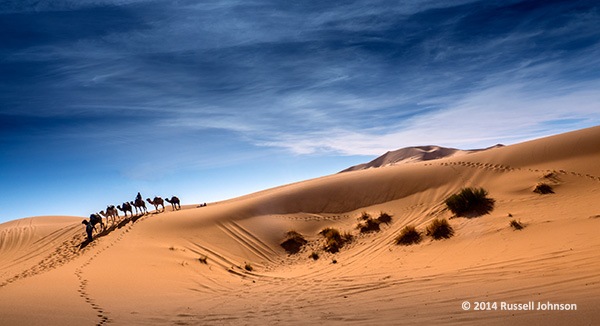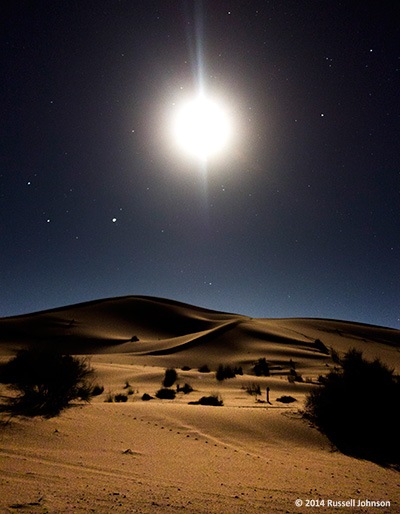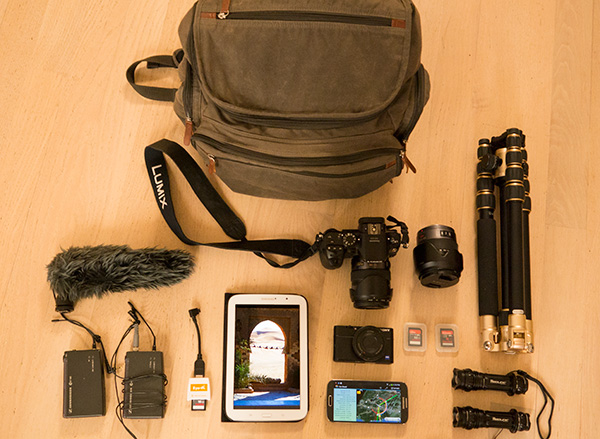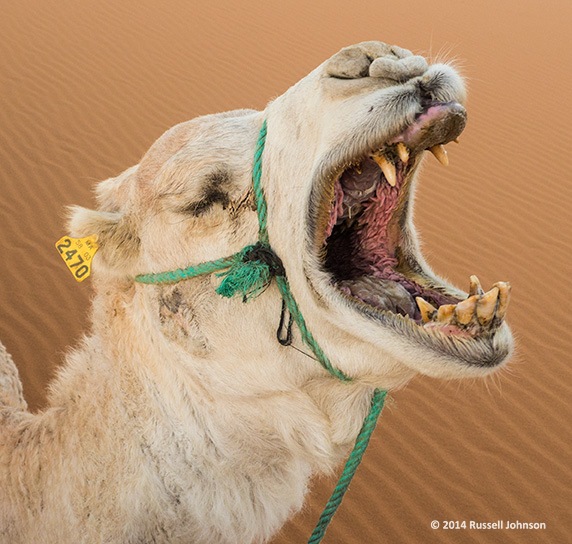aNewDomain.net — Our Travel Editor, Russ Johnson, packs enough tech gear into his small bag, slung to the back of a camel, to shoot a poor-man’s version of Lawrence of Arabia. And that’s exactly what he did. Read below for the journalistic, highly-technical escapade of our desert wanderer. Oh, and check the photos, they are magic.
The camel is, to be frank, a cantankerous mammal.
Like a U.S. congressman it may hiss and gurgle, dig in its hoofs and refuse to budge. And when displeased, which is often, a camel sounds like a cross between a braying jackass and a flushing toilet.

Sahara Caravan, Morocco, Photo credit: Russ Johnson
The Journey
Aiming to please (the camel) I packed light for my Sahara safari. I had to jam all of my photo and video gear into a small backpack — not to mention extra clothes, underwear and toiletries, all of which hung about my stinky friend’s bony body.
In truth, it was not as difficult as it may seem. Gear of all kinds, photo and travel in specific, is far lighter and more manageable than it was just a few years ago.
The temperatures on the Moroccan Sahara can drop below freezing at night, and I was to sleep in a tent.

Midnight at the Oasis, Photo credit: Russ Johnson
Layering was the answer: a t-shirt, sweater and non-iron long sleeve that I could easily scrunch into a bag made up the base layer. I traded my heavy fleece coat for a Calvin Klein nylon and duck down jacket from Costco. It’s feather-weight, literally, and small enough to stuff into a small bag that hangs from my belt. Not to mention really warm.
The Gear
I have always been obsessed with bags. Almost every trip, I re-assess my equipment and go bag shopping. Gone are the days when gearing up for a photo/video shoot means monstrous suitcases. I sometimes had to pack two full-sized suitcases filled with videotape, batteries and chargers, not to mention a video camera the size and weight of a watermelon, a couple of Nikon camera bodies, lenses, etc.
Now I can shoot a TV special with the gear stuffed into a backpack and still have room for a mobile phone, tablet, tripod and enough lighting to illuminate a sand dune. And usually I still have space to spare.

Camera Kit for the Sahara. Photo credit: Russ Johnson
My bag of choice for the Sahara safari is a mini backpack made by Dopp. Smaller than a regular backpack, it has the advantages of being fairly shallow and light toned with a large flap and lots of pockets. How many times have you fumbled around looking for something in a deep, dark bag, especially when you were in a hurry to photograph a fleeting moment? It also looks cool — made of synthetic canvas, like something Peter O’Toole would have carried when scenes from Lawrence of Arabia were filmed here.
My camera gear is not quite up to the 1961 technology used in Lawrence. 65mm film is the equivalent of 8K video. Japanese TV is playing with 8K, but the rest of the world is just getting into 4K.
The camera I carry does a meager, but top quality, 1080p. My light Panasonic GH3 matches or beats high-end Canons in video quality, plus it has microphone and headphone jacks and audio controls. It also doubles as an excellent 16mp still camera. At CES this year, Panasonic announced that it would release a 4K version later this year.
So I pack the GH3, two lenses (a fast F2.8 24-70 35mm equivalent and a 28-320 do-everything lens) and a spare pocket cam in the form of a Sony RX100. Now, if I was to be doing anything more athletic than crossing the desert on a lumbering camel, I would have also packed a GoPro.
I slip a short shotgun microphone with a wooly “mouse” windscreen into my bag, in this case one made specifically for the GH3, plus a Sennheiser wireless mic.
I pack a MePhoto travel tripod. It weighs 3.6 lbs, folds down on itself, fits into a backpack and doubles as a monopod. Handy.
For lighting, forget about flash. I HATE the built-in flash on a camera and rarely use it. Instead I pack two Redline Select mini flashlights. Made for law enforcement, they can light up a perp half a block away. They are adjustable to up to 310 lumens, and can be focused from a narrow beam to floodlights. You can use one as a spotlight to light up a face and another to flood the rest of the scene, or cranked up all the way, illuminate a building or a sand dune.
I carry enough memory to shoot my entire trip — about 100 GB in 16 and 32GB chips. But, what do I do for backup and how do I see what I have photographed? I could lug a laptop or buy an expensive portable hard drive with a viewer. But how about something smaller, more elegant and cheaper?
My choice for both viewing and backup is a Samsung Galaxy Note 8 tablet. I could have even used my Galaxy phone or any other Android device that has a slot for a micro-SD card, which can store up to 64GB. That’s enough for most trips. With an OTG (on the go) micro-USB cable I purchased on Amazon for a few dollars and a card reader, I can use the tablet to both back up and view photos and videos. Sorry iPad users. Although you can attach a non-Apple card reader, you only have a fixed amount of storage.
To use a card reader, I had to enable mass storage on the device. Instructions on that here.
To organize my pictures I use a file manager called ES File Explorer. The tablet will not read RAW files without an extra paid app, so I shoot in both RAW and jpeg and back up both on the tablet.
Then I use that old fave Snapseed to do rough edits and upload to social networks, postponing the heavy lifting for Photoshop at home. There are really no good video editing programs for Android tablets, but I do use an app called MX Player to preview videos. It plays high-bitrate .MOV files from my Panasonic and AVCHD files from the little Sony, marking them with thumbnails.

The Camel Doth Protest Too Much, Photo credit: Russ Johnson
So, I am loaded up, ready to go and assigned a camel whom I decide to name Leroy — for a boy in my middle school class who had very bad breath and entertained (or so he thought) his classmates by making gross noises. I board, wobbly, my little backpack tied to Leroy’s saddle. I lumber off into the desert.
Here is a slide show of some of the scenes I photographed:
Back, after the voyage, settled into a desert Kasbah, I huddle around a wireless hotspot with other members of my caravan. We digitally elbow each other for limited bandwidth. I upload a portrait of Leroy to Facebook. My dentist posts a comment: “No wonder he’s ornery, he has periodontal disease.”
For aNewDomain.net, I’m Russ Johnson.
Based in Sonoma, California, Russ Johnson is the founder of Travelmedia and a senior editor at aNewDomain.net covering travel. Email him at Russ@aNewDomain.net and follow him @connectedtravlr.














Fantastic information, all! Thank you, especially, for the simple, compact lighting trick:
For lighting, forget about flash. I HATE the built-in flash on a camera and rarely use it. Instead I pack two Redline Select mini flashlights. Made for law enforcement, they can light up a perp half a block away. They are adjustable to up to 310 lumens, and can be focused from a narrow beam to floodlights. You can use one as a spotlight to light up a face and another to flood the rest of the scene, or cranked up all the way, illuminate a building or a sand dune.
I’m going to give this a try!